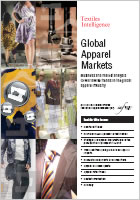Issue
6:
2nd Quarter 2009

Product Overview
Buy this Report now
Buy this Issue now
Subscribe
Download brochure (PDF)
Download price list (PDF)
Price list download
| Please choose your preferred currency:
|
Request sample issue
View list of reports
in other issues
|
Multi Report Package |
We also offer a flexible subscription product,
the Multi Report Package,
which allows you to select your own choice of reports from our full range,
to suit your own budget.
Click here for full details.
|
|
 |
Global apparel markets: business update, 2nd quarter 2009 |

29 pages,
published in Issue 6, 2nd Quarter 2009
Report price:
Euro 395.00;
US$ 520.00
|
Abercrombie & Fitch and Gildan have reported poor financial results for the early months of 2009. But results at Marks & Spencer (M&S) are relatively upbeat, and UK-based Asos has continued to grow apace. One of the biggest casualties of the global economic slowdown has been the Germany-based luxury fashion group Escada, which filed for bankruptcy protection in August 2009. However, before doing so, it managed to sell four women?s fashion brands?apriori, BiBA, cavita and Laurèl, which belonged to its wholly-owned subsidiary The Primera Group?to two German firms.
In the area of anti-counterfeiting, authorities have seized thousands of counterfeit clothing items in Sri Lanka, Thailand and Italy. In an attempt to combat counterfeiting activities, the EU launched an official observatory. Other intellectual property matters included the filing of two trademark infringement cases?one by Gucci against Guess and another by Kay Celine against Stein Mart and Sienna Rose.
Many companies have been taking steps to deal with the consequences of the global economic slowdown. Triumph International, for example, has reduced its workforce by about 8%, or 3,600 jobs. Meanwhile, UPM Raflatac has continued to transfer production of its radio frequency identification (RFID) tags and inlays to China and the USA. Other strategic activities have included: the signing of a global licensing agreement between Calvin Klein and Premium Golf Brands (PGB); collaboration between Fast Retailing and Jil Sander to develop a new clothing collection for Uniqlo; Iconix China?s development of the Rocawear brand in China and its acquisition of a 50% stake in Hardy Way; a licensing agreement between Sony Computer Entertainment Europe (SCEE) and Target Entertainment relating to the development of PlayStation-branded apparel; and two agreements relating to the distribution of Tory Burch products in Japan and South Korea.
Market data show that global sales of apparel and home textiles made from organic cotton rose by 63% to reach US$3.2 bn in 2008, while sales of ethical clothing in the UK are expected to be worth £175 mn in 2009. In the Americas, the management consulting firm AT Kearney has named Brazil as the most attractive emerging market for apparel retailers in 2008, for the second year in a row.
Several major brands have opened new clothing stores in various countries or are planning to do so?including Adidas in Saudi Arabia, Gap in Thailand, H&M in China, Top Shop in the USA, and Zara in Egypt. Japan-based Uniqlo and China-based Taobao have launched two virtual stores dedicated to selling Uniqlo products online to consumers across China. Meanwhile, Guess has invested in product life cycle management (PLM) software to manage its global sourcing and product development.
- Business update
-
- Summary
- Acquisitions, divestments and mergers
- Anti-counterfeiting and trademark infringement
- Company restructuring and reorganisation
- Financial results
- International trade policy
- Joint ventures, cooperation, licensing and distribution agreements
- Markets
- New stores
- Online retailing
- Product life cycle management (PLM)
- Textile and apparel certification and standards
| Global Apparel Markets provides intelligence, analysis and insight on the global apparel industry. |  | What's in it?
Each issue contains: essential information on trade and trade policy; news from leading brands, companies and other organisations; analysis of key geographical markets; and expert opinions on strategy. A single issue of Global Apparel Markets includes:  practical and strategic advice from industry experts practical and strategic advice from industry experts  a report on a key geographical market a report on a key geographical market  a round-up of the latest product innovations a round-up of the latest product innovations  a feature on trade and trade policy a feature on trade and trade policy  comprehensive information on the latest business developments comprehensive information on the latest business developments
An annual subscription to Global Apparel Markets is a cost-effective way to keep informed about trends and developments in the global apparel industry. Subscriptions are available in printed and/or digital formats. Printed and digital subscribers receive each issue in printed format in addition to a digital PDF file, which is available immediately on publication. Subscribers also receive a complementary digital subscription to Global Apparel Update, delivered directly by email once a month. This free supplement contains essential information on business news and the latest product developments. Like all Textiles Intelligence publications, Global Apparel Markets is a reliable source of independently sourced business information, and it does not carry advertising.
| This is what our customers say: |
"In our work, we were looking for industry insights and trends - who the major suppliers were, which countries were producing and what, productivity rates, investment incentives, where investors were moving to and why, etc. A lot of the individual country case studies you did were great - I remember one recently on the UK for example. There was also a great article from a guy on the Turkish market and recent trends there. Both these articles were written for the layman so they were easy to understand but comprehensive at the same time.
The technology articles were also interesting.
Basically, it was an all-round good publication that covered everything in enough depth so that you would always find something of interest in each issue." |
| (Alan J. Saffery; Competitiveness, Private Sector & Economic Growth ; Saffery Consulting) |
|
|
 |
